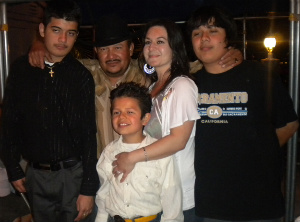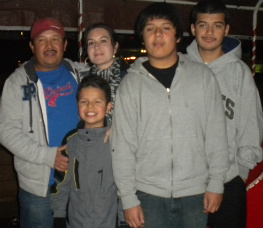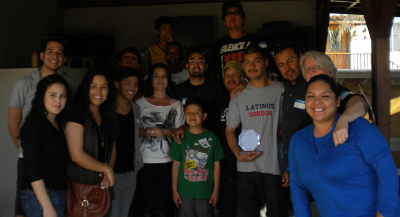
Left to right: Felix, Mr. Sanchez, Mrs. Sanchez, and Hector. Enrique in the front.
Irma Sanchez has three young sons who love football and video games, so when they’re all home, visitors might be surprised by what they hear: absolute silence.
Sanchez’s three sons were all born Deaf and must communicate using American Sign Language (ASL). Inspired by her journey to learn ASL, Sanchez started the group “Deaf Latinos” – a free weekly class at her South Los Angeles home where Sanchez teaches ASL in Spanish.
Felix was eight months old when Sanchez had him tested for hearing loss. A red flag went up for Sanchez when she noticed that her child wasn’t turning around for loud noises, like when the vacuum cleaner was on. Doctors diagnosed him with bilateral sensorineural hearing loss – he was deaf. Sanchez was shocked to learn Felix was deaf. “I recall coming home and sitting down and thinking to myself, ‘Okay, so I have a deaf child, what am I going to do?’”
Besides learning an entire new language, one of her options was to have an implant inserted into Felix’s ears so that he would be able to hear and learn to speak.
Sanchez recalls her conflicting emotions about taking “the easy way” out by having a hearing device inserted into her son’s ears. “But if I do that… that means that I don’t love my child because I’m changing him… I’m taking away that identity.” Instead, she decided to learn ASL to communicate with her now seventeen-year-old son.
“I said to myself – pick yourself up and do the right thing and teach that child how to tell you what he needs,” Sanchez says.
When Sanchez became pregnant with another son two years later, she was prepared for another deaf diagnosis. Hector, fifteen-years-old, was also born deaf but was paired with an Early Start teacher right away to start learning ASL. Early Start is a government program that places an in-home ASL interpreter to teach deaf infants and their families to communicate. Sanchez’s youngest son, 11 year-old Enrique, was was also born deaf.

Left to right in the foreground: Enrique, Hector, and Felix. The background: Mr. and Mrs. Sanchez.
Sanchez’s husband opted not to undergo gene testing with his wife to discover whether their genes were simply incompatible and produced deaf children or whether the deaf gene was limited strictly to male offspring.
Latinos are the largest minority within the deaf community. In 2005, the Gallaudet Research Institute reported that 24.5 percent of deaf and hard of hearing students in the United States were Latino. In California, Latino deaf/hard-of-hearing students make up the majority of all deaf students with 53.9 percent of the student population (aged 21 and younger).
Sanchez made the decision to not implant hearing devices in any of her sons.
“My major concern was, I didn’t want them to hate me when they were older and say, ‘Why did you change me? Why didn’t you let me be who I am or who I was born to be?’” Sanchez says.
Years later, Felix, Hector, and Enrique all unanimously agree that their parents made the right decision.
“They tell me that they don’t want to be Hearing and that they’re glad that I didn’t make the decision of implanting them,” Sanchez says.
The boys’ acceptance of their deaf identity undoubtedly comes from their mother’s own willingness to accept their culture and ASL. From the time she learned her first son was deaf, Sanchez was proactive in learning ASL to communicate with her children.
“I always said to myself, these are my kids and it’s my responsibility to raise them,” she says.
Sanchez became increasingly involved in the deaf community as her sons grew, eventually being asked to serve as a parent mentor in Parent Links, a Department of Education program that connects parents of deaf children. Since Sanchez speaks both English and Spanish, she was in charge of reaching out to Spanish-speaking parents to guide them on what resources were available to teach them ASL.
Sanchez says she noticed “a lack of information towards [the Latino] community… there was a lack of support as well.” Specifically, there were rarely any Spanish classes available that taught ASL.
Sanchez realized how difficult it was for Spanish-speaking parents to find ASL classes taught in Spanish. So, she founded the Deaf Latinos group two years ago to help bridge that gap.
Most Latino families who have deaf children only speak Spanish. Sanchez had an advantage of speaking both English and Spanish, so when she found out Felix was deaf, she was able to join ASL classes taught in English. She also learned ASL through Hector’s Early Start teacher and constantly interacting with other deaf people.
Sanchez sees steady attendance at the weekly “Deaf Latinos” classes. There are typically about 10 families that attend regularly and every week a new family tries out a class. Sanchez notes that because a new family joins almost every class, she has to backtrack and re-teach basic skills that had been covered in previous lessons.

A “Deaf Latinos” event with a Deaf college student panel.
The “Deaf Latinos” group also provides a social source of support to connect these families together.
Even though “Deaf Latinos” is geared mostly towards the Latino community, Sanchez says many white, Asian and African-American families participate in the group.
However, simply having access to free ASL classes is not always enough to inspire some parents to learn their child’s language. Some parents “refuse to even consider signing with their kids because they’re like – ‘No. It’s hard,’” Sanchez says. “’It’s hard to learn. It’s hard enough learning English, it’s going to be harder to learn another language.’”
Melinda Tindall, an educational interpreter at Alta Loma Junior High School, says she notices this same kind of attitude with Latino parents. “I have heard parents say that it’s really hard because they speak Spanish,” Tindall said. “They come here from a different country – and they also are in a culture shock.”
First-generation Latino parents who have deaf children are suddenly thrust into another culture with a brand new language to learn. These parents were still becoming accustomed to the American culture and then must adapt to another culture that they did not choose to participate in. Despite the presence of free classes and programs for Latino parents, like Sanchez’s Deaf Latinos group, most Latino parents choose not to learn ASL to communicate with their deaf children.
Educators who work with deaf students also notice that although Latino students make up the majority in their classrooms, most of their parents do not sign. Tindall estimates that “about eighty percent” of the students in her junior high deaf program are Latino. Deaf students usually create a bond with their educators and fellow classmates, because “they really don’t have a strong communication at home, whether it be with their parents or their siblings,” Tindall says.
Adam Reesman, a deaf and hard of hearing teacher at Alta Loma High School says “Spanish-speaking parents with deaf kids are 95 to 100 percent obsolete in the process” of interacting with their children. “Maybe it’s a culture thing… I don’t have enough research on it. That’s an epidemic. I’ve seen that since I’ve been in the classroom.”
Like Sanchez, Reesman started a free weekly class for the parents of his students to learn ASL. He conducts these classes in his own free time and does not get paid for it. Despite the free ASL classes, Reesman says “Latino parents don’t even show up.”
Patty Manson, a deaf and hard of hearing teacher specialist at Alta Loma is also aware of the problem. “Three out of nine of my parents can carry on basically a pretty immature, low level conversation with their child.” Eight of Manson’s students are Latino and none of their parents can sign as well as their children can.
Manson, also the mother of a deaf son, learned sign language by attending classes. Even Manson’s daughter became a sign language interpreter as a result of learning ASL to communicate with her brother. But Manson says that her husband attended two classes with her and then stopped.
Learning sign language takes a lifelong commitment, not just a sporadic attendance at sign language classes. “It’s not something that you can take just one class,” Manson says. “It’s ongoing.” Manson’s similar situation to Sanchez shows that the language barrier between families and deaf children resonates beyond Latino families.
Sanchez suggests one way to encourage Latino parents of deaf children to sign would be if television featured deaf Latinos. Sanchez mentions Academy Award winning deaf actress Marlee Matlin and the new ABC Family show “Switched at Birth,” which includes a young hard of hearing actress who uses ASL. However, Sanchez notes that these were all female Caucasians. She says, “if we were to see more Latino deaf adults, maybe, that would encourage parents to accept their kids the way they are and pick up that sign language.”
Some people might think that suddenly having a child who is deaf or hard of hearing might be a curse. But Sanchez says that the best thing about her family is the fact her sons are all deaf.
“I had to learn a new language. I had to learn about a new culture,” Sanchez says. “It made me more humble. It made me a better person. It just completely changed my life.”
All photos courtesy of Irma Sanchez
News package and audio slideshow by Laura Santana
This article was originally published on Intersections South LA in 2011.















I’d like to find out more? I’d care to find out some additional
information.